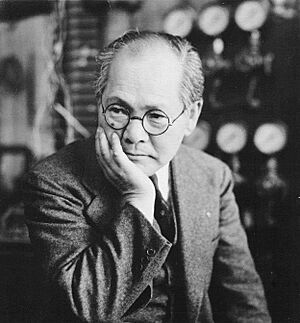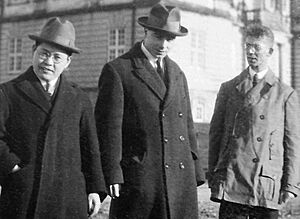Yoshio Nishina facts for kids
Quick facts for kids
Yoshio Nishina
|
|
|---|---|
| 仁科 芳雄 | |
 |
|
| Born | December 6, 1890 Satoshō, Okayama
|
| Died | January 10, 1951 (aged 60) |
| Nationality | Japanese |
| Known for | Klein–Nishina formula |
| Awards | Asahi Prize (1944) Order of Culture (1946) |
| Scientific career | |
| Fields | Physics |
| Institutions | RIKEN |
| Notable students | Hideki Yukawa Sin-Itiro Tomonaga Shoichi Sakata |
Yoshio Nishina (仁科 芳雄, Nishina Yoshio, December 6, 1890 – January 10, 1951) was a Japanese scientist. Many people call him the "father of modern physics research in Japan." He also led a science project in Japan to study atomic energy during World War II.
Contents
Early Life and Education

Yoshio Nishina was born in Satoshō, Okayama, Japan, in 1890. He was a very bright student. In 1918, he graduated from Tokyo Imperial University as an electrical engineer. He was the top student in his class and even received a special silver watch from the emperor.
After university, he joined the Institute of Physical and Chemical Research, which is now called RIKEN. There, he started learning about physics from a famous scientist named Hantaro Nagaoka.
Research in Europe
In 1921, Yoshio Nishina traveled to Europe to do more research. He visited several important universities and science centers. One of the most important places he visited was the University of Copenhagen in Denmark.
In Copenhagen, he worked with the famous scientist Niels Bohr. They became very good friends. In 1928, Nishina and another scientist named Oskar Klein developed an important idea. It is now known as the Klein–Nishina formula. This formula helps explain how light interacts with tiny particles called electrons.
Building Science in Japan
Yoshio Nishina returned to Japan in 1929. He worked hard to create a good place for studying quantum mechanics. This is a part of physics that looks at how tiny particles behave.
In 1931, he started his own lab at RIKEN, called the Nishina Laboratory. He invited many famous scientists from other countries to Japan. These included Werner Heisenberg, Paul Dirac, and Niels Bohr. Their visits helped Japanese scientists learn new things and grow their own research.
In 1931, Nishina also gave talks about a theory called Dirac theory in Kyoto. Two of his future Nobel Prize-winning students, Hideki Yukawa and Sin-Itiro Tomonaga, attended these talks.
Atomic Energy Project
During World War II, Yoshio Nishina was involved in Japan's efforts to study atomic energy. His laboratory was badly damaged during the war. Much of its equipment had to be thrown away and rebuilt later.
On August 7, 1945, Nishina led a team of scientists. They were sent to Hiroshima to find out if the city had been attacked with an atomic bomb. After checking the area, he confirmed that an atomic bomb had been used. He sent this information back to Tokyo on August 8.
After the War
After World War II, the US Army forces in Japan took apart Nishina's cyclotron machines. These machines are used to speed up tiny particles for research. The parts were dumped into Tokyo Bay. This event caused a big stir in the United States. Nishina later wrote about how he felt about his cyclotrons being destroyed.
Two American physicists, Harry C. Kelly and Gerald Fox, worked with the US forces. Kelly stayed in Japan until 1950 and became good friends with Nishina. Nishina spoke English, which helped them communicate.
At one point, the US Army wanted to remove some Japanese scientists from their jobs. Nishina's name was on this list. Harry Kelly was asked to give his opinion about Nishina. Kelly said that Nishina was a respected scientist around the world and had spoken against the war. He believed it would be wrong to remove him.
Nishina wanted to restart science in Japan after the war. Kelly helped him with this. Nishina had two main goals: getting special materials called radioisotopes for research and keeping RIKEN as a science research center. RIKEN owned parts of some large companies, and the US forces wanted to break it up. Eventually, an agreement was reached, and Nishina became the head of the reorganized RIKEN.
Scientific Discoveries
Yoshio Nishina made many important contributions to science. He helped create the Klein–Nishina formula, which we mentioned earlier. He also studied cosmic rays, which are high-energy particles from space.
He built several particle accelerators called cyclotrons at RIKEN. Using these, he found a particle that was later identified as the muon. He also discovered a new type of uranium called uranium-237. He was one of the first to study how uranium splits when hit by fast particles. He almost discovered a new element called neptunium.
Nishina was a main researcher at RIKEN. He guided and taught many younger physicists. Two of his students, Hideki Yukawa and Sin-Itiro Tomonaga, later won the Nobel Prize.
Later Life and Legacy
Yoshio Nishina passed away in 1951 from liver cancer. His friend Harry Kelly stayed close to Nishina's family after his death. Years later, Kelly's ashes were buried next to Nishina's grave in Tokyo.
See also
 In Spanish: Yoshio Nishina para niños
In Spanish: Yoshio Nishina para niños
- Nishina Memorial Prize
- Nishina, a crater on the Moon named in Nishina's honor.

